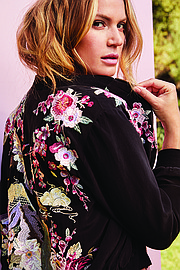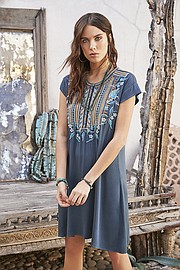FASHION
With Fashion Design in Her DNA, Theresa McAllen Elevates the Johnny Was Family
After starting with Johnny Was from its inception during the early 1990s, the company’s senior vice president of design, Theresa McAllen, continues to cultivate the brand. From studying at Brooks College in Long Beach and New York’s Parsons School of Design to working with Brooklyn designer Jean Betancourt and starting her own lines, all of McAllen’s experiences have brought her to this point.
As Johnny Was expands into additional categories and opens 14 stores this year, the Los Angeles native discussed with the California Apparel News her path to becoming a fashion designer.
When did you decide you wanted to be a fashion designer and why?
My grandmother and aunt were incredible seamstresses. They had no formal training but made all of their patterns from scratch. For me, as a young child, to see the transformation of them coming back with these beautiful garments, I was completely fascinated by it.
How did you make that happen?
When I was 9, my mom started teaching me how to sew. So I started making clothes for Barbies. When I got into high school, I started making halter dresses and hand embroidering them. I got very into macramé, embroidery, knitting and crocheting.
Who was the person who helped you the most in becoming a fashion designer?
I believe this wouldn’t have happened without my mother, Eva McAllen. She made a lot of sacrifices for me to go to fashion school. She didn’t have a lot of money, but she always believed in me and encouraged me to create. All the good qualities I have come from her.
Looking back on your first collection, what was it like and how would you change it now?
We were working with one fabric, which was a rayon georgette. If I could change something, I would have added in a few other fabrications, although that fabric has become our iconic cloth, which is still used and universally loved today.
What are the biggest challenges you find in creating a collection and how do you overcome them?
The deadlines can seem daunting. We have so much product now because the line has grown so much. We’re expanding our look to many different categories. We have a lot on our plate, but it’s all very well received, and it’s exciting to feel that we’re going to the next level.
Where do you get your inspiration?
We have a 30-year library here because we started doing embroidery in the 1990s, but we’ve collected too. We have a huge collection of vintage kimonos. We also do a lot of travel, which is inspirational and important for designers to get out of the routine.
What is your favorite part of being a fashion designer?
I love working together to come up with ideas. The excitement when you look at the prototype and it looks better than the sketch or the tech pack—I still get a high from that.
What skills are necessary to be a good fashion designer?
Creativity and the ability to get excited about what is going on in the fashion world and reinterpret it.
How would you describe your personal style?
For me, I love to mix patterns. I like mixing odd combinations, even with color. I am so happy with this trend toward animal prints because I love to mix it with plaids. For Holiday 2019, we have a velvet animal print that we’ll put in.
What is the best and worst feedback or critique you have received and from whom?
My mom is in a senior-living community. She has dementia, but I dress her, and she is the best-dressed woman in the place. People are constantly telling me that every day they wait to see what she is going to wear. Fashion is uplifting. It makes people happy and brings joy. The worst feedback has been, “JW is such a top-driven collection, I wish there were more offerings in bottoms.”
How has the Los Angeles fashion industry changed since you started?
It’s really respected. Los Angeles was seen as more of a denim or juniors market in the past, but things have really opened up. People are in awe of L.A. right now.
What advice would you give to emerging designers?
I really believe in draping, patternmaking and understanding the construction. It helps you fall in love and connect you with it. This ties back to my grandmother and aunt. They were—without even knowing it or having the training—draping these garments by instinct.

























